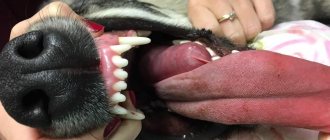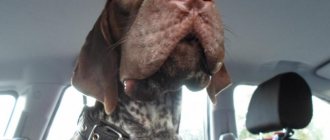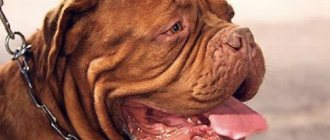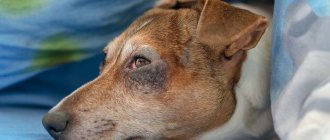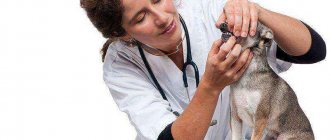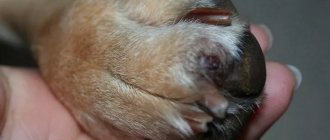Classification
Myositis is an inflammation of the dog's muscle tissue. It can occur in both acute and chronic form.
There are several types of this disease:
- Traumatic myositis - develops as a result of sprains, impacts, tears and other injuries to muscle tissue.
- Purulent myositis - develops due to infection (streptococci, staphylococci, etc.) entering the damaged muscle tissue. With this form, abscesses filled with pus form.
- Rheumatic myositis – often develops in dogs with weakened immune systems. Usually the neck and back muscles are affected.
Symptoms of myositis in dogs
Myositis often develops in those dogs that are regularly exposed to increased stress (hunting, working and herding breeds). The muscles of the shoulder, hips, lower back, back and neck are usually affected. Here are the main symptoms of different types of myositis:
Type of disease and its symptoms
- Traumatic. The dog moves slowly and carefully, visibly protecting the affected area. Upon palpation, you can detect compactions in the sore muscle. The tissues are hot and swollen to the touch. Many pets eat poorly and become lethargic.
- Purulent. Such myositis is often a consequence of a traumatic form. An abscess forms in the affected muscle, in which pus accumulates. When opened, a brown fluid (a mixture of pus and blood) flows out of the wound. With purulent myositis, the animal's temperature rises. The pet is depressed, refuses to eat, and tries to walk as little as possible.
- Rheumatic. With this form of myositis, the dog has difficulty getting to its feet and becomes very nervous if the sore muscles are touched. Inflammation can spread from the affected area to the neighboring one, which causes severe pain to the pet. With this form of the disease, the muscles of the back and lower back are usually affected, so the dog hunches over and has difficulty defecating.
Important. All types of myositis are united by one symptom - severe pain in the affected muscle tissue. A pet suffering from such a disease tries not to make unnecessary movements, eats poorly and is in a depressed state.
Signs of illness
A concerned owner begins to notice that in the morning his pet moves very carefully and stiffly. The dog thinks for a long time where to place his paw, whines, squeals in pain even at the slightest movement. These are the first signs of myositis.
Subsequently, when the disease begins to progress, symptoms increase:
- body temperature rises;
- loss of appetite;
- the dog does not allow himself to be petted, growls and snaps;
- significantly limits his motor activity, stops jumping, tries to avoid all obstacles;
- sore muscles become swollen, tense and hot to the touch;
- Sometimes convulsions occur.
- damage to the skin may be noticeable;
- blood appears in the urine;
- the dog stops defecating or does it very rarely. It's obvious that this is causing her pain.
Inflamed muscles cause the animal a lot of suffering. When the masticatory muscles are affected (jaw myositis), eating causes enormous pain, and it is difficult even to simply bark. If inflammation affects the muscles of the cervical and occipital region, it becomes impossible for the dog to tilt or raise its head.
When the first characteristic symptoms of the disease occur, it is necessary to conduct a timely examination and identify the cause, on which treatment tactics will depend.
Causes of myositis in dogs
Myositis often develops in active animals that run a lot, overcome obstacles and work in conditions of high humidity (hunting in swamps, etc.).
Here are the main reasons for the development of the disease in dogs:
- muscle hypothermia (swimming in bodies of water in the cold season, staying in the rain for a long time, walking after swimming);
- colds;
- age (rheumatic myositis develops more often in older dogs);
- excess weight (in this case the load on the animal’s muscles increases);
- allergic reactions;
- weakened immune system;
- injuries, bruises, sprains;
- infection of a muscle wound.
Many dogs of hunting breeds suffer from myositis , which pursue prey for a long time across fields and wet grass. After such work, lactic acid accumulates in the muscles, and hypothermia only accelerates the development of the disease.
Prevention measures (diet)
For inflammatory processes in the muscles, the diet is based on the principles of proper nutrition. It is mandatory to have plenty of fresh fluids and adhere to the drinking regime, consuming at least 2000 ml of drinks per day (green tea, rosehip decoction, cranberry or lingonberry juice, raspberry tea).
When examining your pet in the clinic, the doctor will give recommendations on the predominant use of certain products in the dog’s menu and will include proper nutrition in the treatment plan.
The principles of nutrition for myositis include eating foods containing vitamins and easily digestible proteins.
Preference should be given to products with vitamins E, A and C (tomatoes, sweet peppers, green salad, kiwi fruits, plums, citrus fruits, green apples with a sour taste, vegetable oil), which will help neutralize harmful substances formed during myositis.
Next come easily digestible proteins found in soy, ground beef, chicken, oysters and almonds.
Including foods containing natural substances with analgesic and anti-inflammatory properties (root vegetables, carrots, potatoes, beets) in your dog’s diet will help in the dog’s recovery.
To reduce inflammatory processes, stewed or boiled fish will be useful.
It is important to include in your dog’s diet foods high in calcium (lactic acid products, currants, gooseberries, parsley and cabbage), magnesium (cereals) and zinc (liver, eggs, cheese and pumpkin).
To protect your pet from inflammatory diseases of various origins, it is necessary to take preventive measures, which include:
- vaccinations against infectious diseases;
- quarterly deworming;
- temperature control;
- identification of allergic reactions;
- strengthening the immune system;
- moderate physical activity, avoid exhausting forced marches for working dogs.
The disease is always accompanied by suffering, and if it is myositis, then by the inability to fully move. To avoid inflammatory processes, it is necessary to monitor your pet’s health from the first months of life and not neglect visits to the veterinary clinic and the advice of doctors.
Treatment of myositis in dogs
A dog suffering from myositis must be kept in a warm room, as cold and dampness will only worsen the condition.
Before starting treatment, the animal should be examined.
Diagnosis of myositis includes the following procedures:
- ultrasound examination (with its help, the veterinarian finds swelling, bruises and muscle tears);
- Voll diagnostics (this method allows you to evaluate the conductivity of nerve impulses)
- Dopplerography (assessment of blood flow in the affected muscle).
Myositis most often affects hunting dogs.
In case of traumatic myositis, cold is applied to the affected area in the first couple of days after a bruise or sprain. To prevent infection, the veterinarian makes a blockade with an antibiotic (Bicillin-5, etc.). The use of warm compresses and paraffin applications has a good effect.
Purulent myositis is treated according to the following scheme:
- The resulting abscesses are opened, the liquid (a mixture of blood and pus) is removed, and the affected areas are washed with hydrogen peroxide.
- If the affected area is large, the veterinarian will apply stitches. Be sure to make a drainage (a hole in the skin through which pus and other fluids that accumulate in the wound come out).
- A mixture of novocaine and an antibiotic (Bicillin-5, Penicillin, etc.) is injected into the inflamed muscle.
- Anti-inflammatory and painkillers are prescribed for oral administration (Rimadyl, Ketoprofen, Baclofen, Mydocalm, Diclofenac, Analgin, etc.).
Classification
It has several forms. Depending on how the disease develops and what tissues are involved, the following types are distinguished:
- Purulent melting of skeletal muscles.
- Parenchymal myositis.
- Interstitial.
- Fibrinous.
Purulent often occurs as an acute one and is of an infectious nature. With this form of the disease, pus appears between the muscle fascia; over time, the process spreads and destroys the muscles.
In the photo in veterinary textbooks you can also see it, with the opening of an independent abscess to the outside and the flow of pus. Parenchymal most often occurs after injury, muscle fibers are involved.
Interstitial affects intermuscular fascia, ligaments and other types of connective tissue. Fibrous is manifested by ossification of muscles, its growth.
Such myositis is the most severe and cannot be treated, almost always leading to disability. According to etiological characteristics, they are divided into the following types:
- Infectious.
- Rheumatic.
- Eosinophilic.
Infectious ones can be serous and purulent, caused by bacteria, less often viruses, or protozoa. Rheumatic and eosinophilic refers to autoimmune diseases, damage occurs to the leg muscles, near the joints.
Symptoms
Purulent forms occur after injury.
The bruise does not heal for a long time, swelling appears on the paw, and the dog tries not to step on it. If an abscess forms in the muscle, a localized tumor can be identified. With diffuse myositis, a large area is affected. Often the purulent form is accompanied by general symptoms, fever, decreased activity, and loss of appetite.
Eosinophilic myositis occurs in the masticatory muscles. The dog has difficulty opening its mouth, refuses to eat, and stops barking. This form goes away on its own, but recurs over time and can lead to atrophy of the masticatory muscles.
Rheumatic myositis often occurs after a cold, and this disease occurs more often in large dogs. It also affects animals that live in outdoor enclosures.
The dog becomes less active, steps on the sore limb with caution, limps, and begins to hunch his back.
Recently an advertisement was filmed about a dog with myositis, in this video the symptoms of the disease are very clearly visible.
Treatment
Much depends on the form.
It is not always possible to cure purulent at home. Sometimes this type of disease requires surgery. An antibiotic, anti-inflammatory drugs, immunomodulators and a number of vitamins are required.
Drug therapy for rheumatic myositis includes the use of salicylates (aspirin, butadiene). Inflammation can also be relieved with local ointments containing salicylic acid.
In severe cases, use hormonal medications. Eosinophilic myositis requires immunosuppressive therapy. Initially, prednisolone 1-2 mg per kilogram of weight. If it does not give results, move on to cytostatics (cyclophosphamide, azathioprine).
Traditional methods of treating myositis in dogs are also used. For rheumatic fever, you can prepare your own ointment with aspirin and methyl salicylate. Take 15 g of one and the other drug, add to it 150 ml of ammonia and 100 ml of flax seed oil.
What to do at home
Myositis in dogs is a disease in which the muscles become inflamed. During the treatment period, the animal should have a warm, soft place and good nutrition. This mandatory addition to drug treatment helps the body weakened by the disease to gain strength for recovery.
It is important to create a favorable psychological climate around the pet: the dog should be in a state of absolute calm. You need to talk to her while performing the compresses and other procedures prescribed by the doctor.
Depending on the damage to the muscles, it is difficult for the animal to move, so the pet must be sure that even to change its position, a caring owner will come to the rescue. You need to know that lying down for a long time can cause bedsores.
By providing attention and assistance to the dog, the owner demonstrates how dear the pet is to him. Only together, only through joint efforts can we defeat the disease.
Classification
It has several forms. Depending on how the disease develops and what tissues are involved, the following types are distinguished:
- Purulent melting of skeletal muscles.
- Parenchymal myositis.
- Interstitial.
- Fibrinous.
Purulent often occurs as an acute one and is of an infectious nature. With this form of the disease, pus appears between the muscle fascia; over time, the process spreads and destroys the muscles.
In the photo in veterinary textbooks you can also see it, with the opening of an independent abscess to the outside and the flow of pus. Parenchymal most often occurs after injury, muscle fibers are involved.
Interstitial affects intermuscular fascia, ligaments and other types of connective tissue. Fibrous is manifested by ossification of muscles, its growth.
Such myositis is the most severe and cannot be treated, almost always leading to disability. According to etiological characteristics, they are divided into the following types:
- Infectious.
- Rheumatic.
- Eosinophilic.
Infectious ones can be serous and purulent, caused by bacteria, less often viruses, or protozoa. Rheumatic and eosinophilic refers to autoimmune diseases, damage occurs to the leg muscles, near the joints.
Symptoms
Purulent forms occur after injury.
The bruise does not heal for a long time, swelling appears on the paw, and the dog tries not to step on it. If an abscess forms in the muscle, a localized tumor can be identified. With diffuse myositis, a large area is affected. Often the purulent form is accompanied by general symptoms, fever, decreased activity, and loss of appetite.
Eosinophilic myositis occurs in the masticatory muscles. The dog has difficulty opening its mouth, refuses to eat, and stops barking. This form goes away on its own, but recurs over time and can lead to atrophy of the masticatory muscles.
Rheumatic myositis often occurs after a cold, and this disease occurs more often in large dogs. It also affects animals that live in outdoor enclosures.
The dog becomes less active, steps on the sore limb with caution, limps, and begins to hunch his back.
Recently an advertisement was filmed about a dog with myositis, in this video the symptoms of the disease are very clearly visible.
Treatment
Much depends on the form.
It is not always possible to cure purulent at home. Sometimes this type of disease requires surgery. An antibiotic, anti-inflammatory drugs, immunomodulators and a number of vitamins are required.
Drug therapy for rheumatic myositis includes the use of salicylates (aspirin, butadiene). Inflammation can also be relieved with local ointments containing salicylic acid.
In severe cases, use hormonal medications. Eosinophilic myositis requires immunosuppressive therapy. Initially, prednisolone 1-2 mg per kilogram of weight. If it does not give results, move on to cytostatics (cyclophosphamide, azathioprine).
Traditional methods of treating myositis in dogs are also used. For rheumatic fever, you can prepare your own ointment with aspirin and methyl salicylate. Take 15 g of one and the other drug, add to it 150 ml of ammonia and 100 ml of flax seed oil.
This mixture is applied to the paw and wrapped in a bandage. To prevent the dog's bandage from slipping, it is covered with a special mesh and polyethylene on top. Keep the compress for 30-40 minutes. But it is better to contact a veterinarian at the first symptoms of the disease; he will make a correct diagnosis and prescribe the correct treatment.



